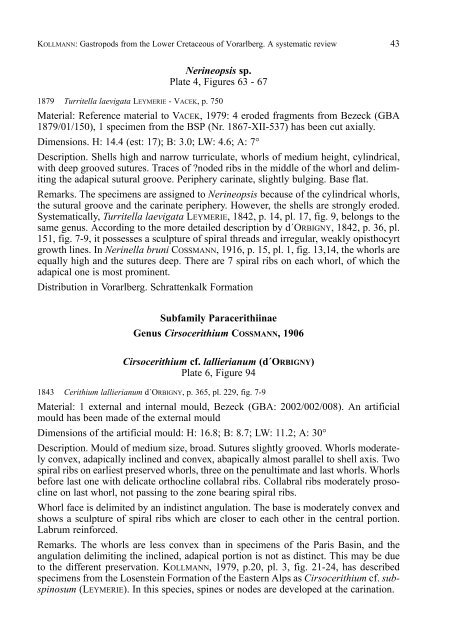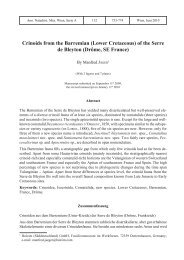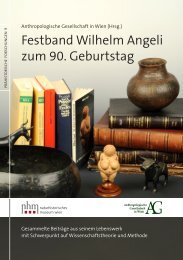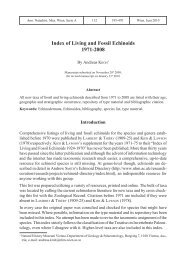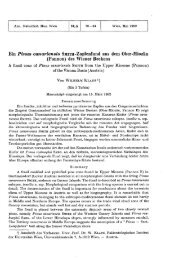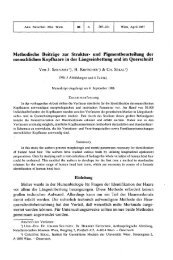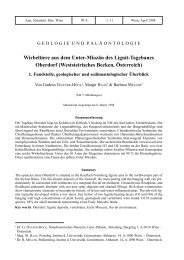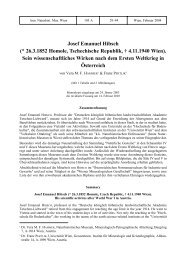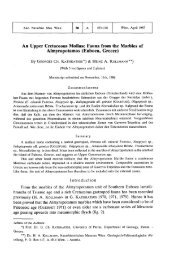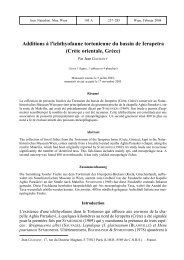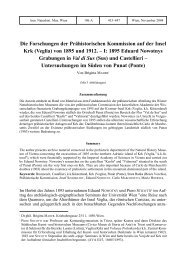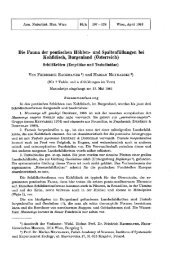Gastropods from the Lower Cretaceous of Vorarlberg, Austria. A ...
Gastropods from the Lower Cretaceous of Vorarlberg, Austria. A ...
Gastropods from the Lower Cretaceous of Vorarlberg, Austria. A ...
Create successful ePaper yourself
Turn your PDF publications into a flip-book with our unique Google optimized e-Paper software.
KOLLMANN: <strong>Gastropods</strong> <strong>from</strong> <strong>the</strong> <strong>Lower</strong> <strong>Cretaceous</strong> <strong>of</strong> <strong>Vorarlberg</strong>. A systematic review 43<br />
Nerineopsis sp.<br />
Plate 4, Figures 63 - 67<br />
1879 Turritella laevigata LEYMERIE - VACEK, p. 750<br />
Material: Reference material to VACEK, 1979: 4 eroded fragments <strong>from</strong> Bezeck (GBA<br />
1879/01/150), 1 specimen <strong>from</strong> <strong>the</strong> BSP (Nr. 1867-XII-537) has been cut axially.<br />
Dimensions. H: 14.4 (est: 17); B: 3.0; LW: 4.6; A: 7°<br />
Description. Shells high and narrow turriculate, whorls <strong>of</strong> medium height, cylindrical,<br />
with deep grooved sutures. Traces <strong>of</strong> ?noded ribs in <strong>the</strong> middle <strong>of</strong> <strong>the</strong> whorl and delimiting<br />
<strong>the</strong> adapical sutural groove. Periphery carinate, slightly bulging. Base flat.<br />
Remarks. The specimens are assigned to Nerineopsis because <strong>of</strong> <strong>the</strong> cylindrical whorls,<br />
<strong>the</strong> sutural groove and <strong>the</strong> carinate periphery. However, <strong>the</strong> shells are strongly eroded.<br />
Systematically, Turritella laevigata LEYMERIE, 1842, p. 14, pl. 17, fig. 9, belongs to <strong>the</strong><br />
same genus. According to <strong>the</strong> more detailed description by d´ORBIGNY, 1842, p. 36, pl.<br />
151, fig. 7-9, it possesses a sculpture <strong>of</strong> spiral threads and irregular, weakly opisthocyrt<br />
growth lines. In Nerinella bruni COSSMANN, 1916, p. 15, pl. 1, fig. 13,14, <strong>the</strong> whorls are<br />
equally high and <strong>the</strong> sutures deep. There are 7 spiral ribs on each whorl, <strong>of</strong> which <strong>the</strong><br />
adapical one is most prominent.<br />
Distribution in <strong>Vorarlberg</strong>. Schrattenkalk Formation<br />
Subfamily Paracerithiinae<br />
Genus Cirsocerithium COSSMANN, 1906<br />
Cirsocerithium cf. lallierianum (d´ORBIGNY)<br />
Plate 6, Figure 94<br />
1843 Cerithium lallierianum d´ORBIGNY, p. 365, pl. 229, fig. 7-9<br />
Material: 1 external and internal mould, Bezeck (GBA: 2002/002/008). An artificial<br />
mould has been made <strong>of</strong> <strong>the</strong> external mould<br />
Dimensions <strong>of</strong> <strong>the</strong> artificial mould: H: 16.8; B: 8.7; LW: 11.2; A: 30°<br />
Description. Mould <strong>of</strong> medium size, broad. Sutures slightly grooved. Whorls moderately<br />
convex, adapically inclined and convex, abapically almost parallel to shell axis. Two<br />
spiral ribs on earliest preserved whorls, three on <strong>the</strong> penultimate and last whorls. Whorls<br />
before last one with delicate orthocline collabral ribs. Collabral ribs moderately prosocline<br />
on last whorl, not passing to <strong>the</strong> zone bearing spiral ribs.<br />
Whorl face is delimited by an indistinct angulation. The base is moderately convex and<br />
shows a sculpture <strong>of</strong> spiral ribs which are closer to each o<strong>the</strong>r in <strong>the</strong> central portion.<br />
Labrum reinforced.<br />
Remarks. The whorls are less convex than in specimens <strong>of</strong> <strong>the</strong> Paris Basin, and <strong>the</strong><br />
angulation delimiting <strong>the</strong> inclined, adapical portion is not as distinct. This may be due<br />
to <strong>the</strong> different preservation. KOLLMANN, 1979, p.20, pl. 3, fig. 21-24, has described<br />
specimens <strong>from</strong> <strong>the</strong> Losenstein Formation <strong>of</strong> <strong>the</strong> Eastern Alps as Cirsocerithium cf. subspinosum<br />
(LEYMERIE). In this species, spines or nodes are developed at <strong>the</strong> carination.


